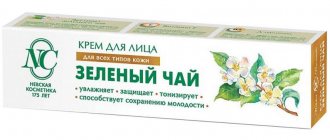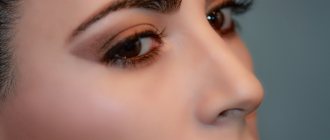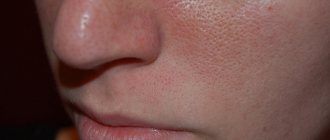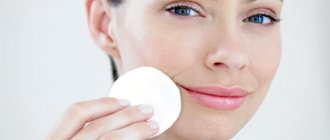What does SPF 50 stand for?
The abbreviation SPF (Sun Protection Factor) stands for skin protection factor from exposure to ultraviolet rays. Thin, dry, freckled skin needs to be protected year-round. Choose foundations and BB creams with at least SPF 20 for residents of Moscow and St. Petersburg, and young girls will need products marked SPF 30.
Did you know that...
Residents of northern regions age more slowly due to the low impact of UV rays on the skin.
Applying SPF 50 daily is not recommended unless you plan to spend the entire day in the sun. But even with protection, you should avoid direct rays; SPF 50 protects 98% from aggressive UVB rays. There is no 100% effective sunscreen yet!
Organic UVB filters –
UVB radiation has high intensity only in summer, and specifically in the time range from 10 a.m. to 4 p.m. Therefore, if you want to avoid getting sunburnt on the beach, these filters are the most important, but at the same time they are not able to protect your skin from photoaging (which is caused by UVA radiation).
1) Ethylhexyl triazone – synonym – Uvinul T-150. This is an organic filter that well blocks UVB radiation (from 280 to 315 nm), and also, to a small extent, UVA-2 rays. It is often combined with the Tinosorb-S broad spectrum filter. Ethylhexyltriazone has a fairly high safety profile. Recommended concentration up to 5%.
2) Iscotrizinol – full name – Diethylhexyl butamido triazone. This organic filter blocks UVB radiation well, as well as to a small extent UVA-2 radiation (peak at 314 nm). Has a good safety profile.
3) Aminobenzoates – the earliest sunscreens used para-aminobenzoic acid (PABA), which stained clothing and caused skin irritation. Therefore, instead of traditional PABA, its derivatives began to be used - 1) octyldiethyl-PABA, 2) padimate O (Padimate O). It is believed that not only PABA itself, but also all its derivatives significantly increase the risk of developing photoallergic dermatitis. At the moment, the use of aminobenzoates has been almost completely replaced by the next group of filters - cinnamates.
4) Cinnamates – one of the most commonly used UVB filters, which is included in not only creams, but also makeup products, lipsticks, and hair conditioners, is Octyl methoxycinnamate. Its other names are ethylhexyl methoxycinnamate, octinoxate, and OMS. This substance is poorly soluble in water, and therefore it is especially often included in sun protection products labeled “water resistant.” Most often it is combined with another organic filter - oxybenzone.
Cinnamates have a number of significant disadvantages. For example, they do not have very good photostability, and therefore, without combination with photostabilizers, they quickly decompose in the presence of sunlight. Also, cinnamates easily penetrate the skin and also lead to the formation of free radicals. They cannot be used by children and pregnant women, because... they may cause estrogen-like side effects, causing statistically significant changes in testosterone and estradiol levels. Sometimes they can cause photoallergic dermatitis.
5) Octocrylene - this filter can be found in almost all sunscreens of low and medium price categories. This is a rather weak organic filter, which in good products will not be used as the main active component. But, if you start looking at the compositions of different products, you will see that in many cheap products octocrylene is the main component in a very high concentration (or in combination with cinnamates). But its presence in higher quality products is explained by the fact that it has high photostability and can act as a photostabilizer for other organic filters.
Octocrylene can also be used in sun protection products as an additional UVB filter (but it also has little activity against UVA-2 radiation). Despite its widespread use, this filter has a number of disadvantages. It easily penetrates the skin and leads to the production of free radicals. May act as a photosensitizer, contributing to the development of photoallergic dermatitis. Octocrylene is the most common component of cheap sun protection products, where it is usually found in very high concentrations (up to 10%) - usually in combination with cinnamates or salicylates.
6) Salicylates - salicylates are fairly weak absorbers of UVB radiation, and therefore they are used either in high concentrations (about 4%) or to enhance other UVB filters. They also tend to reduce the photodegradation of UV filters such as oxybenzone and avobenzone. In sunscreen products, you can find the following salicylates - Octyl salicylate or Octisalate or 2-ethylhexyl salicylate, Homosalate, and triethanolamine salicylate. These components are considered safe; cases of allergic reactions to salicylates are extremely rare.
7) Phenyl-benzimidazole-sulfonic acid –
This component is used only for protection against UVB radiation (it also has little activity against UVA-2 radiation). This filter has a good safety profile and cases of allergic reactions are extremely rare. In the ingredients list, this component will be written as Phenylbenzimidazole sulfonic acid (24stoma.ru).
Why use sunscreen?
It used to be that aristocratic pallor was the highest degree of beauty, but over the years there has been a fashion for the hot, tanned bodies of lifeguards and Malibu lifeguards. It is believed that tanning was introduced into fashion, not surprisingly, by the aristocrat Coco Chanel in the 20s of the 20th century. For a long time she did not allow her dazzling skin to tan, but one day an incident happened, and the trendsetter became covered with a bronze tint. But Coco was not at a loss and announced that “asperin-colored skin” is no longer relevant, and tanned skin glows with health and passion.
Beautiful aristocrats hid their wide-brimmed hats, summer gloves, and veils away and went to the seashores to sunbathe. A special tanning boom hit American youth in the 50s and 60s of the 20th century!
But something went wrong...
Doctors gradually began to notice that it was the skin that was exposed to the sun for a long time that was most susceptible to the formation of wrinkles, irregularities, age spots, and spider veins. While the areas in protected places - the lower abdomen, inner thighs, etc., remain in better condition. As a result, scientists came to the conclusion that it is not age that affects the appearance of signs of aging on the face, but UV radiation, which can cause abnormalities in DNA and dermal molecules.
Therefore, it is imperative to use sunscreen, and instead of regular foundations, choose ones with UV protection.
- You will be 98% protected from burning.
- The risk of early wrinkles will decrease.
- Preventing the development of skin cancer.
- Protection against freckles and large age spots.
The sun's UVA rays destroy the elastic fibers of our skin and reduce collagen production. The condition of the skin under these rays worsens even in childhood and wrinkles may appear!
Chemical (organic) filters –
Organic filters in sunscreens can be used either as an addition to mineral filters (allowing you to increase the SPF of the product and provide protection even from intense UV radiation), or as the main protection factors.
Different organic filters have different disadvantages. For example, they do not reflect the sun's rays as mineral filters do, but absorb them, dissipating them later in the form of heat. In addition, some organic filters cause allergic reactions and are also able to be absorbed into the systemic bloodstream. Another problem (not with all, but with most organic filters) is their photostability. The point is that, when exposed to sunlight, they can participate in photochemical reactions, which can result in the formation of: 1) free radicals that damage the skin, 2) chemical byproducts that can change the structure of other chemicals. For example, an organic filter such as avobenzone can be destroyed by 36% after just 15 minutes of exposure to sunlight on skin treated with a sunscreen containing this component.
The most important thing is that the chemical byproducts formed as a result of this reaction begin to destroy other organic substances that make up the sunscreen, and if they are absorbed, they can lead to skin damage, cause allergic reactions, and increase the risk of developing contact dermatitis. Organic filters, which have poor photostability, have a low cost and therefore you can always find them as part of inexpensive sun protection products. To reduce the rate of destruction of such filters, manufacturers use additional chemistry, which gives organic filters greater photostability.
However, not all organic UV filters are equally harmful, and among them there are some that are quite worthy of our attention. It should be noted that most organic filters are not able to protect the skin from the entire spectrum of UV radiation at once, and therefore we further divided them into 3 groups - 1) broad UVA-UVB spectrum filters, 2) UVA filters, 3) UVB filters
Types of sunscreens?
Creams differ in the principle of operation - the type of sun filters. There are 2 main types Sunscreen and Sunblock, and the common one is a combination of these filters.
Sunscreen
The main components of such protection are avobenzone, homosalate, octisalate, oxybenzone . Of these, only avobenzone is safe for skin, including children’s skin (from 6 years old). And homosalate does not neutralize UV exposure on its own. The last three components are harmful; oxybenzone generally works like the hormone estrogen (and this can cause malfunctions in the body).
Sunblock
This option is considered the safest and is classified as mineral. Blocks UVA and UVB rays, 98% effective. The active ingredients are: titanium dioxide and zinc oxide . I recommend choosing creams with zinc oxide - the safest option.
The third option is to combine the Sanscreen and Sanblock components. For example, one cream can use, for example, avobenzone and zinc oxide (a good combination, quite safe), or oxybenzone and titanium dioxide (this combination can cause harm!).
Organic UVA filters –
- Mexoril® SX – full name – terephthalyidene dicamphor sulfonic acid. The organic filter Mexoril SX is a patented development of L'Oreal, and you can only find this filter in cosmetics of those brands that belong to this company (for example, La Roche-Posay, Vichy, SkinCeuticals), as well as in inexpensive cosmetics sold under its own brand. brand L'Oreal.
It is often written that Mexoril SX is a broad spectrum filter that protects against both UVA and UVB. This needs clarification. The fact is that Mexoril SX protects only from a small part of the UVB radiation spectrum, which does not allow it to be fully regarded as an effective remedy for these purposes. As for UVA radiation, this filter protects against its entire spectrum. However, it shows really high effectiveness for protection against UVA-2 rays - while the effectiveness against UVA-1 rays will be only moderate.This filter is highly photostable and has virtually no effect on the body. Studies have shown that sunscreen containing 5% Mexoril SX effectively prevents photoaging. In addition, it reduces the formation of pyridine dimers in the skin (in response to UV irradiation), and thus reduces the risk of skin cancer. A special feature of Mexoril SX is that the absorbed UV radiation is then released in the form of thermal energy outward, rather than heating the tissue.
- Uvinul A Plus - full name - diethylamino hydroxybenzoyl hexyl benzoate. A good organic filter against UVA radiation (from 320 to 400 nm, with a UV absorption peak of 354 nm). It has excellent photostability and compatibility with other UV filters. Approved for use in sunscreens in the EU at concentrations up to 10%.
- Oxybenzone – Oxybenzone is considered a broad spectrum filter for all UVA radiation. Nevertheless, it should be noted that this substance perfectly absorbs UVA-2, but to a lesser extent - UVA-1. According to statistics, oxybenzone is included in about 30% of all sun protection products, and its big disadvantage is that of all sunscreen components, oxybenzone has the greatest likelihood of causing contact or photoallergic dermatitis. It has been established that oxybenzone can cause allergic skin reactions and is also absorbed into the systemic circulation (it is subsequently excreted in the urine). For this reason, products containing oxybenzone are not recommended for children. In addition, oxybenzone is not sufficiently photostable, and its inclusion in the product requires additional photostabilizers. An analogue of oxybenzone, which is also used in sun protection products, is sulisobenzone, which has similar properties.
- Avobenzone (Avobenzone) - synonyms - butylmethoxydibenzoylmethane (Butyl-methoxydibenzoylmethane) and Parsol-1789 (Parsol-1789). This substance is one of the few organic filters that provides effective protection against the entire spectrum of UVA radiation. However, we have already discussed that avobenzone lacks photostability and is rapidly degraded when exposed to UV radiation. The breakdown process can produce free radicals as well as various by-products including aromatic acids, phenols, aldehydes and acetophenones. Avobenzene is relatively easily absorbed into the systemic circulation and often causes photoallergic dermatitis.
A filter such as octocrylene tends to reduce the photodegradation of avobenzene in the sun, but mineral filters ZnO and TiO2, on the contrary, further worsen its photostability. It should be noted that a number of manufacturing companies have developed proprietary technologies for stabilizing avobenzone (for example, Helioplex™, Active Photo Barrier Complex™, Dermaplex™, SunSure™ and AvoTriplex™). In addition, microencapsulated versions of avobenzone are now being developed that will be even safer and more stable - even when mixed with mineral filters.Unfortunately, once you see avobenzene in the ingredients, you will never be able to know whether the stabilized or unstabilized form is used in this product. The only exception may be if the manufacturer additionally indicates on the packaging as a competitive advantage that the product uses one of the above-mentioned patented technologies (Helioplex™ or others).
Rating of the 7 best sunscreens
Let's move on to the most interesting thing - a full-fledged top of protective products against UV rays. The products presented in the rating are as natural and safe as possible for the skin. But finding more or less high-quality sanitary blocks for the face or soft sanitary screens turned out to be quite difficult. The presented creams will save snow-white skin from heat and aging. Don't forget, dark-skinned women need to use sunscreen too!
AVENE Soins Solaires AV SPF 50+
An ideal solution for those with sensitive skin prone to the formation of age spots after exposure to the sun. French-made day cream controls the process of melanin production with the help of titanium and zinc dioxide components. The cream gets rid of existing stains and prevents new ones from appearing! The product remarkably moisturizes and nourishes the epidermis, while protecting 98% from UV rays.
The manufacturer indicates that the cream does not contain fragrances or parabens, but does contain PEG, EDTA, and Methylparaben. Of course, it’s great that the main active ingredients are sanitary blocks, but I don’t recommend using them for daily use!
Volume - 50 ml Price - 1000 rubles
RUBORIL EXPERT SPF 50+
Recommended for those with thin and dry skin over the age of 35. Protects against redness and rosacea formation. The sunscreen resembles a BB fluid, slightly evens out the tone and mattifies. Must be used daily before going outside.
The active component is zinc oxide. There are parabens in the composition, so it is not recommended to use it constantly, only in the summer.
Volume - 30 ml
Price - 1200 rubles
A'Pieu Pure Block Natural Daily Sun cream SPF45/PA+++
Korean-made sunscreen is not very popular in Russia, but is very famous in Asia. You can also buy it only in Korean online stores. Refers to Sanskrin, the composition contains extracts of pomegranate, bird cherry, eucalyptus, rose, watermelon, aloe vera. The main component that blocks UV rays is avobenzone. The composition contains synthetic substances and small dosages that act as preservatives and extend the life of the product.
Volume - 50 ml Price - 800 rubles
SPF-50 Sun Wellbeing Nature's
Italian product to protect skin from sunburn. Transmits 2% of rays, but protects against destruction of the elastic fibers of the dermis. It contains a lot of useful things - almond oil, melon juice, apricot extract, coffee oil and jojoba.
The main component against UV exposure is titanium dioxide. But the composition cannot be called natural; the cream contains PEG and various emulsifiers, but no parabens!
Although the cream is only 70% natural, it is of sufficient quality and can become your veil on the seaside.
Volume - 50 ml Price - 800 rubles
Medium Holy Land Age Defense CC Cream SPF50 (Medium)
Anti-aging CC cream with high protection against UV rays, belongs to professional cosmetics, recommended by cosmetologists and makeup artists. The cream gives the skin a light tan, evens out the tone well and mattifies perfectly.
The composition is quite good, the main components are zinc oxide, mineral oil, Gingko Biloba and camellia extracts. But again, there are parabens, I recommend using the cream only in the summer. And if you do not plan to be in the sun for a long time, then use gentler products with SPF 50.
Volume - 50 ml Price - 1000 rubles
Ultra-high protection baby sunscreen milk SPF 50 Alphanova® bebe Alphanova
Natural cream can be used not only for children's skin, but also for adult skin. The product is more or less natural, but not without alcohol in its composition. But preservatives and emulsifiers are of plant origin. All natural sunscreens have a white coating immediately after applying the cream and a short shelf life (2-3 months).
Active components against UV radiation - aluminum oxide and squalane, do not harm the skin, but protect.
Volume - 50 ml Price - 1500 rubles
Sunscreen body cream Calendula SPF 50 Levrana
Natural creams have the property of being absorbed for a long time, the shelf life is only 3 months. The main active ingredients are titanium dioxide, zinc oxide, additionally it contains extracts of calendula and walnut, rose hips, string, chamomile, flaxseed oil, almond oil, tea tree oil, emulsifiers and preservatives of plant origin.
The bottle has a dispenser, but you need to make sure that the container is not in a vertical position, the cream may leak due to its liquid consistency.
It is absorbed in about 1-2 minutes, leaving white streaks at first. You need to apply the cream 30 minutes before going out into the sun. A huge minus is that the cream remains white in the folds of the skin. But if you choose naturalness, effectiveness, or skin without white streaks, I’d rather choose white streaks and figure out how to get rid of them faster than poisoning the dermis!
No parabens, fragrances or synthetics in the composition!
Volume - 100 ml Price - 750 rubles
Organic UVA-UVB filters –
The UVA-UVB filters listed below are the best available in sun protection products today. Mexoril XL, Tinosorb-S and Tinosorb-M - can be found in good concentrations only in high-quality and expensive cosmetics.
- Mexoril® XL – (synonym – drometrizole trisiloxane, Drometrizole trisiloxane).
This is probably one of the best and safest organic filters, which protects well from UVB radiation, as well as the entire spectrum of UVA radiation (and especially well from UVA-1). The Mexoril XL filter is a patented development of L'Oreal, and you can only find it in cosmetic brands owned by this company. Such brands include, for example, La Roche-Posay, Vichy, SkinCeuticals. Moreover, in less expensive cosmetics sold directly under the L'Oreal brand, you can find another Mexoril, namely Mexoril SX. This is also a good and safe organic filter, but it does not protect against the entire spectrum of UV radiation (but mainly against UVA-2 radiation). In more expensive products, these 2 filters are usually combined together, because these complement each other well. Mexoril XL and SX have very good photostability and do not affect the body. - Tinosorb-S – (synonym – Bemotrizinol, Bemotrizinol).
Full name: Bis-ethylhexyloxyphenol methoxyphenyl triazine. Tinosorb S is a broad-spectrum organic filter, protecting against both UVB and UVA radiation. Moreover, its maximum effectiveness occurs precisely with UVA-1 and UVA-2 radiation. This filter is highly photostable: even when exposed to UV radiation equivalent to 50 MED (minimum erythema dose), 98.4% of the filter molecules remain intact. Most often, this filter is additionally combined with the Tinosorb-M filter, as well as ethylhexyltriazone. In general, Tinosorb S (as well as Mexoril XL) is one of the most powerful organic filters. - Tinosorb-M – (synonym – Bisoctrizole, Bisoctrizole). Full name: Amethylene bis-benzotriazolyl tetramethylbutylphenol. This is a unique filter against UV radiation, because... it is a hybrid, simultaneously possessing the properties of both a mineral and an organic filter. The range of the ultraviolet spectrum covered is both UVB and UVA (both UVA-1 and UVA-2). This filter has excellent photostability and has virtually no effect on the body.
Noni Care - reliable protection for lips from UV rays
You need to protect not only your skin, but also your lips! You don't want wrinkles around the mouth and shriveled lips from lack of moisture? Girls with such problems are increasingly found on the streets of the city, and the reason is insufficient protection of their lips from UV rays.
Contains coconut, olive, shea, cocoa oils, vitamins, wax, and various plant extracts. There are no chemicals in the composition! The manufacturer claims that Noni Care balm protects against age-related folds on the lips, dryness and loss of lip volume. Recommended to use all year round!
Cost - about 200 rubles
Personally, I chose Levrana cream for myself, I will write a detailed review on it separately, after testing its strength under the scorching sun!
Types of UVA and UVB radiation filters –
Below you can find out: what products can be called a truly high-quality sunscreen for the face - rating of the best products of 2020 (according to our medical editors). But before that, we will tell you in detail about the pros and cons of various UVA-UVB radiation filters that are used in sun protection products. This data will allow you not only to understand our arguments in choosing the best sunscreen, but also to independently analyze the composition of such products in the future.
Types of sun filters –
Reviews
Deoproce company, UV defense sun cream spf50+ PA+++ Korea. I've never seen anything better! My husband instantly burns even from the Ural sun, but with this cream he easily survived under the Thai sun in December. We can conclude that the texture is not liquid, it is easy to apply, does not leave marks, and is used sparingly.
Dobrovrushka
https://www.u-mama.ru/forum/women/fashion/801199/
Premium is ours, professional. The Beauty Institute releases. I think this is the only cosmetics we have in Russia that can compete with global brands. By the way, they have SPF protection up to 100; for those who need to protect their skin, I would not recommend limiting yourself to 50.
Taisiya Demyanova
https://www.woman.ru/beauty/face/thread/4435318/
There will be no non-comedogenic ones with this SPF. They are all white, fat and shiny. I can recommend a moisturizing fluid from Arabia.
Summer. A
https://www.woman.ru/beauty/face/thread/4435318/
What do we protect ourselves from using SPF cream?
A little physics of the process, just a little. Solar radiation consists of waves of different lengths, each length has its own special effect on humans. These effects are distributed over the depth of penetration and are not concentrated only on the surface of the skin.
Significant impact factors include two types of waves - long and medium waves; short waves are almost completely absorbed when passing through the atmosphere.
Two threat factors, solar radiation.
Waves - spectrum - B (designated - UVB) and waves - spectrum - A (designated - UVA) are distinguished as a threat to health.
Burns, a burned back is UVB radiation. When our skin's protective capacity is not sufficient to withstand the intensity of UVB, that's when burns and redness appear. And in a sense, this is not even bad, the skin itself warns us of danger and asks us to either leave the dangerous place or put on some clothes.
But from UVA, this protection mechanism does not work; our skin does not react painfully to the effects of these rays. At the same time, these rays penetrate quite deeply and lead to dangerous consequences for health.
While basking in the sun, we are exposed to various influences, which differ from each other in the degree of painful perception, the varying severity of the effects and, of course, different ways of combating their harmfulness.
If we talk about the differences between these two types of irradiation, then for ease of understanding and without going into the chemistry and physics of the process, UVB is painful and leads to superficial burns, UVA is not painful, but triggers the process of photoaging in the deep layers of the skin. These waves differ in time and duration of activity. The picture below illustrates this.
| The danger factors are clear. |
| UVB is straightforward and rough. |
| UVAs are insidious and dangerous. |










